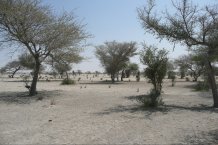Articles

The Sahel region of Africa is a semi-arid landscape between the desert to the north and the savannah to the south.
Summer rainfall in vulnerable African region can be predicted
Summer rainfall in one of the world’s most drought-prone regions can now be predicted months or years in advance, climate scientists at the Met Office and the University of Exeter say.
The Sahel region of Africa – a strip across the southern edge of the Sahara from the Atlantic Ocean to the Red Sea – is a semi-arid landscape between the desert to the north and the savannah to the south.
Much of the food produced in the Sahel depends on summer rainfall, and the region experienced major droughts during the 1970s and 1980s.
The new research used the Met Office Hadley Centre’s Decadal Prediction System and found that the model was good at predicting summer Sahel rainfall over the forthcoming five years.
Forecasting years ahead relies on sea surface temperature in the North Atlantic, whereas the El Niño Southern Oscillation is important for a shorter-term forecast before each summer.
“Our study suggests that skilful predictions of summer rainfall in the Sahel are now possible months or even years ahead,” said Dr Katy Sheen, formerly of the Met Office but now of the University of Exeter’s Penryn Campus in Cornwall.
“With a population reliant on agriculture, the Sahel is particularly vulnerable to major droughts, such as those of the 1970s and 1980s.
“Improved understanding and predictions of summer rainfall in the Sahel has the potential to help decision makers better anticipate future cycles of summer droughts and floods, helping local communities become increasingly resilient to the region’s notoriously variable and changing climate.”
By analysing data from the past, the researchers checked whether the model would have predicted the lack of rainfall associated with the prolonged droughts of the 1970s and 1980s – and they found it was very effective.
“Our study improves our understanding of the driving mechanisms of summer rainfall variability and shows they are predictable,” Dr Sheen added.
The study, published in the journal Nature Communications, is entitled: “Skilful prediction of Sahel summer rainfall on inter-annual and multi-year timescales.”
Date: 24 May 2017
